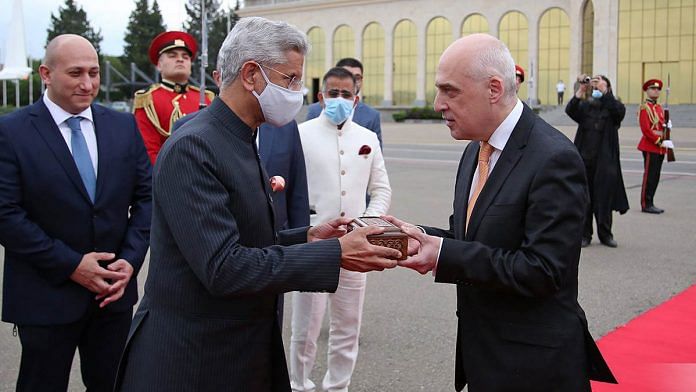New Delhi: External Affairs Minister S. Jaishankar Friday handed over a relic belonging to St Queen Ketevan, a royal from the 17th-century, to the Georgian government, taking bilateral ties to a “new level”.
Jaishankar handed over the relic to his counterpart David Zalkaliani, also Vice-Prime Minister of the country, just after he landed in Georgia for a two-day visit.
It was then handed over to His Holiness and Beatitude Ilia II, the Catholicos-Patriarch of Georgia or the spiritual head of the Georgian Orthodox Church, and Prime Minister Irakli Garibashvili.
Delighted to welcome my 🇮🇳 counterpart @DrSJaishankar on his first visit to 🇬🇪, who has brought the relics of 🇬🇪's Queen Ketevan. This visit is to definitely play a huge role in strengthening ties between our countries and upgrade our relations to a completely new level. pic.twitter.com/w2iqQZCwyk
— David Zalkaliani (@DZalkaliani) July 9, 2021
The return of the relic, excavated in Goa in 2016, was lauded by the ruling Georgian Dream Democratic Party as an “unprecedented” gesture and one which will be “remembered and appreciated”.
Ketevan courts deep reverence among Georgians as a martyr of the faith who refused to convert her religion, even though this led to her death.
Also read: India, China not in nuclear arms race, got them with different objectives: Jaishankar in Moscow
Who was St Queen Ketevan?
St Queen Ketevan, also known as Ketevan the Martyr, was the queen of Kakheti, a kingdom in eastern Georgia in the 17th century. She was married to Prince David of Kakheti, who later became the king of the region in 1601 but died just a year later in 1602. After his death, Ketevan devoted herself to religious and charity activities.
David’s father Alexander II, who had been forced off the throne by his son, took over in 1602 and ruled Kakheti, according to the book ‘Edge of Empires: A History of Georgia’ by Donald Rayfield.
Eventually, after a lot of turmoil with the Shah Abbas I of Iran of the Safavid Dynasty, Alexander II was killed by his other son Constantine I, who also converted to Islam at the Safavid court. After ruling for a few years, he died in a battle led by Queen Ketevan.
However, in 1613, Shah Abbas I conquered Kakheti and took Queen Ketevan hostage. She was held as a prisoner in Shiraz, a city in south-central Iran, for 10 years.
Many attempts were made to convert her to Islam and join a harem but she refused. Eventually, she was strangled to death on 22 September 1624.
However, two of her Augustinian friars, who had gone to Shiraz in 1623, were able to get hold of her mortal remains and kept them with themselves till 1627. Some of these were brought to the St Augustinian convent in Goa.
In 2016, after a long hunt, the queen’s remains were found at the Old Goa building.
“We have been able to establish that the remains found in St Augustine Complex in Goa were that of Queen Ketevan of Kakheti in Georgia,” N. Taher, Superintending Archaeologist, Archaeological Survey of India (ASI), Hyderabad Circle, had said while announcing the discovery.
The hunt for the remains was part of a 26-year project carried out by Taher along with a team from the CSIR-Centre for Cellular and Molecular Biology, Hyderabad — comprising Niraj Rai, Manvendra Singh, Aditya Nath Jha and Kumarasamy Thangaraj — and Gyaneshwar Chaubey of Estonian Biocentre and Lalji Singh of Banaras Hindu University.
According to their research paper, Ketevan was canonised by the Georgian Orthodox Church.
“Considering the importance of Queen Ketavan for the Georgian people, Soviet Union-Russian-Georgian officials requested the Government of India to help in tracing the relics of Queen (Saint) Ketevan in Goa,” the paper said.
Also read: India warns OIC against use by ‘vested interests’ after Muslim nation group’s Kashmir remarks
Permanent transfer of the relics
Ever since the relics were excavated, the Georgian government has been urging India to hand them over.
Consequently, in 2017, at Georgia’s request, India sent the relics to the country for an exhibition for six months, according to sources in the Ministry of External Affairs.
The relics were then personally accepted by His Holiness and Beatitude Ilia II along with many Georgians on 23 September 2017.
This loan of relics was extended for another six months, and they spent the year travelling to different churches of Georgia. They were returned to India on 30 September 2018.
According to ministry sources, due to Georgia’s “persistent request” for permanent transfer of the relics — coupled with the historical, religious and spiritual sentiments that are attached to St Queen Ketevan by the Georgian people — New Delhi decided to gift one part of the relics to the government and people of the country.
Sources said this gesture will “strengthen” the bonds of friendship and understanding between India and Georgia.
Jaishankar is the first external affairs minister of India to undertake an official visit to Georgia after it achieved independence from the erstwhile Soviet Union in 1991. Former PM Atal Bihari Vajpayee had visited the country before him when he was the foreign minister in 1978.
Former prime ministers Jawaharlal Nehru and Indira Gandhi also visited Tbilisi in 1955 and 1976, respectively.
Also read: India-Iran pull off a diplomatic surprise as Jaishankar meets President-elect Ebrahim Raisi



